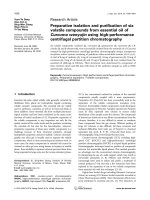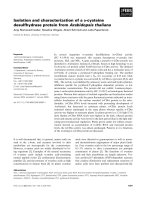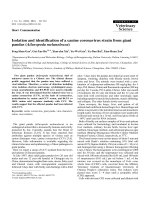Extraction, isolation and identification of four methoxyflavones from leaves of Muntingia calabura L.
Bạn đang xem bản rút gọn của tài liệu. Xem và tải ngay bản đầy đủ của tài liệu tại đây (287.76 KB, 5 trang )
<span class='text_page_counter'>(1)</span><div class='page_container' data-page=1>
<i>DOI: 10.22144/ctu.jen.2020.008 </i>
<b>Extraction, isolation and identification of four methoxyflavones from leaves of </b>
<i><b>Muntingia calabura L.</b></i>
Ngo Quoc Luan1, Tiet Bao Tinh1, Ngo Khac Khong Minh2, Nguyen Phuc Dam1,
Tran Thi Tuyet Hoa1 and Nguyen Trong Tuan1*
<i>1<sub>Can Tho University, Vietnam </sub></i>
<i>2<sub>Nam Can Tho University, Vietnam </sub></i>
<i>*Correspondence: Nguyen Trong Tuan (email: ) </i>
<b>Article info. </b> <b> ABSTRACT </b>
<i>Received 15 Dec 2019 </i>
<i>Revised 25 Mar 2020 </i>
<i>Accepted 31 Mar 2020 </i>
<i><b> Four known methoxyflavones, namely hydroxy-7-methoxyflavone (1), </b></i>
<i><b>5-hydroxy-3,7-dimethoxyflavone (2), 5-hydroxy-6,7-dimethoxyflavone (3) </b></i>
<i><b>and 5-hydroxy-3,7,8-trimethoxyflavone (4) were isolated from acetone </b></i>
<i>ex-tracts of the leaves of Muntingia calabura L. Their structures were </i>
<i>eluci-dated by modern spectra including UV, IR, ESI-HR-MS, 1D-NMR, </i>
<i>2D-NMR and by comparison with published data. </i>
<b>Keywords </b>
<i>Muntingia calabura L., </i>
<i>meth-oxyflavones </i>
Cited as: Luan, N.Q., Tinh, T.B., Minh, N.K.K., Dam, N.P., Hoa, T.T.T. and Tuan, N.T., 2020. Extraction,
<i>isolation and identification of four methoxyflavones from leaves of Muntingia calabura L.. Can </i>
<i>Tho University Journal of Science. 12(1): 58-62. </i>
<b>1 INTRODUCTION </b>
<i>Jamaica cherry (scientific name is Mungtingia </i>
<i>cala-bura L.) or “cây trứng cá” in Vietnamese belonging </i>
<i>to the family Muntingiaceae has been widely grown </i>
in almost all tropical regions and thrives in acidic,
<i>alkaline or drought soil environments (Pereira et al., </i>
<i>2018). Studies on the biological activity of </i>
<i>Mung-tingia calabura have shown that this plant had </i>
<i>anti-bacterial and antifungal properties against </i>
<i>Esche-richia coli, Staphylococcus aureus, Pseudomonas </i>
<i>aeruginosa, Candida albicans, Microsporum canis </i>
and gave effective cancer cell suppression
<i>(Mahmood et al., 2014). Mungtingia calabura </i>
con-tained steroid, tannin, saponin, phenolic and
flavo-noid compounds. These flavoflavo-noids including
fla-vans, flavones, biflafla-vans, chalcones were very
di-verse in structure and occupied large amounts. Chen
<i>et al. (2004) isolated fifteen compounds from the </i>
<i>stem bark of Muntingia calabura. Among these </i>
compounds, three flavones, namely 8‐hydroxy‐
7,3′,4′,5′‐tetramethoxyflavone, 8,4′‐dihydroxy‐
7,3′,5′‐trimethoxyflavone and
3‐hydroxy‐1‐(3,5‐di-methoxy‐4‐hydroxyphenyl) propan‐1‐one exhibited
effective cytotoxicity with ED50 values of 3.56,
3.71, and 3.27 μg/mL, respectively against the P‐
<i>388 cell line (blood cancer cell) in vitro. A chalcone </i>
and three flavones, namely 2',4'-dihydroxychalcone,
3,5,7-trihydroxy-8-methoxyflavone,
5,7-dihydroxy-3,8-dimethoxyflavone and
5-hydroxy-3,7-di-methoxyflavone were determined from the active
fraction of ethyl acetate extract of leaves. Two final
compounds exhibited very strong cytotoxic activity
against HL60 with IC50 values of 3.43 μg/mL and
</div>
<span class='text_page_counter'>(2)</span><div class='page_container' data-page=2>
-7,8,3',4',5',7'',8'',3''',4
''',5'''-decamethoxy-5,5''-bifla-van; 4'-hydroxy-7,8,3',5'-tetramethoxyflavone and
<i>(R)-2'-β-dihydroxy-3',4'-dimethoxydihydrochacone </i>
<i>(Kuo et al., 2014). Chemical composition study of </i>
<i>the dichloromethane extract of the fruit of </i>
<i>Muntin-gia calabura afforded squalene, triglycerides, a </i>
mixture of linoleic acid, palmitic acid and
α-lino-lenic acid, and a mixture of β-sitosterol and
<i>stigmas-terol (Consolacion et al., 2015). </i>
<i>In Vietnam, Muntingia calabura grows everywhere, </i>
and it is a source of easy to find and collect, but the
researches on the chemical compositions and
<i>bio-logical activities of Muntingia calabura has been </i>
ra-ther rare until now. In 2018, three compounds were
isolated from this species including kaempferol,
<i>tiliroside, kaempferol </i>
3-O-(6"-O-galloyl)-β-D-glu-copyranoside (Le Thi Thu Hong and Vo Van Leo
2018). The study on some biological activities of
this species indicated that the ethanolic extract of
leaves gave good antioxidant effect with IC50 of
34.26 μg/mL using DPPH radical scavenging assay.
In addition, it also exhibited the inhibition ability to
<i>some bacterial strains such as P. acnes, S. aureus </i>
<i>and S. epidermidis (Duong Thi Bich et al., 2019). </i>
Aiming at finding bioactive compounds from this
species in Viet Nam, herein, the extraction, isolation
and identification of four compounds from acetone
<i>extracts of leaf of Muntingia calabura were </i>
re-ported.
<b>2 EXPERIMENT </b>
<b>2.1 Plant material </b>
<i>The leaves of Muntingia calabura L. were collected </i>
in Can Tho city in May, 2019. Voucher specimens
have been identified by Dr. Dang Minh Quan, Can
Tho University. After cleaning, poor quality leaves
were removed. Good material was dried at 50°C in
order to decrease the humidity of 0-2%, followed by
<b>crushing into fine powder. </b>
<b>2.2 General experimental procedures </b>
<i>2.2.1 Extraction and purification </i>
Solid-liquid extractions were used with acetone.
Solvent evaporating was accomplished by using
Bu-chi R-210 rotary evaporator system.
Thin layer chromatography (TLC) was carried out
on pre-coasted silica gel 60F254 (0.25 mm)
alumin-ium sheet (Merck) and the compounds were
de-tected under UV (254/365 nm) fluorescence or
spraying 10% H2SO4 solution in ethanol, followed
by heating at 105°C for 1-2 min on electric stove.
For common phase column chromatography
(CP-CC), silica gel 60 (0.040-0.063 mm, Merck) using
<i>increasing polarity solvent systems including </i>
n-hex-ane (H), chloroform (C), ethyl acetate (E) and
meth-anol (M) were used. Compounds were purified by
re-crystallization in pure solvents.
<i>2.2.2 Structural elucidation and identification </i>
Melting point (mp.) was recorded on a melting point
meter (Electrothermal 9100, UK), using capillary;
UV spectra were scanned on Jenway 6315 UV-Vis
photometer (UK); IR spectra were recorded on
Ni-colet 6700 FT-IR spectrometer (Thermo, USA) at
Can Tho University. 1<sub>H-NMR, </sub>13<sub>C-NMR, DEPT, </sub>
HSQC, HMBC spectra were recorded on a Bruker
AM500 FT-NMR spectrometer; Mass spectrum
(MS) was recorded on mass spectrometer (HP 1100
series, LC/MSD Trap, Agilent) at Vietnam
Acad-emy of Science and Technology.
<b>2.3 Extraction and isolation </b>
The dried leaves powder (5.0 kg) was exhaustedly
extracted with acetone 99.9% to gain acetone extract
(0.42 kg).
The acetone extract (LA, 400 g) was subjected to
<i>CP-CC with n-hexane and ethyl acetate (H:E) </i>
sol-vent systems (gradient, 0 to 100% E) as eluent to
give 9 fractions (LA1-LA9).
The fraction LA2 (H:E 10:0; 8.0 g) was taken
<i>CP-CC with n-hexane (100%) as eluent to obtain 6 </i>
frac-tions (LA21-LA26). The fraction LA25 (0.022 g)
<i>was re-crystallized in n-hexane to obtain compound </i>
<b>1 (9.2 mg). </b>
The fraction LA3 (H:E 10:0; 15.0 g) was continued
<i>to CP-CC (n-hexane, 100%) to afford 7 fractions </i>
(LA31-LA37). The fraction LA32 (0.502 g) was
<i>continued to CP-CC (n-hexane, 100%) to give 3 </i>
fractions (LA321-LA323). The fraction LA322
<i>(0.347 g) was re-crystallized in n-hexane to produce </i>
<b>compound 3 (10.1 mg). </b>
</div>
<span class='text_page_counter'>(3)</span><div class='page_container' data-page=3>
<b>2.4 Physical characteristic and spectral data </b>
<b>5-Hydroxy-7-methoxyflavone </b> <b>(1): </b> Yellow
amorphous powder, mp. 164-165°C. ESI-HRMS
<i>m/z 269.0776 [M+H]</i>+<sub>; UV (MeOH, λ</sub>
max): 247, 268,
309 nm; IR (KBr, υ): 3072, 2843, 2360, 1605, 1155,
803, 766 cm-1<sub>. </sub>1<sub>H-NMR (CDCl</sub>
3<i>, 500 MHz, δH ppm, </i>
<i>J Hz) and </i>13<sub>C-NMR (CDCl</sub>
3<i>, 125 MHz, δC ppm): see </i>
Table 1.
<b>5-Hydroxy-6,7-dimethoxyflavone (2): Yellow </b>
amorphous powder, mp. 158-159°C. ESI-HRMS
<i>m/z 299.0899 [M+H]</i>+<sub>; UV (MeOH, λ</sub>
max): 249, 272,
315 nm; IR (KBr, υ): 2942, 1659, 1585, 1448, 1353,
1121, 760cm-1<sub>. </sub>1<sub>H-NMR (CDCl</sub>
3<i>, 500 MHz, δH </i>
<i>ppm, J Hz) and </i>13<sub>C-NMR (CDCl</sub>
3<i>, 125 MHz, δC </i>
ppm): see Table 1.
<b>5-Hydroxy-3,7-dimethoxyflavone (3): Pale yellow </b>
amorphous powder, mp. 160-162°C. ESI-HRMS
<i>m/z 299.0899 [M+H]</i>+<sub>. </sub>1<sub>H-NMR (CDCl</sub>
3, 500 MHz,
<i>δH ppm, J Hz) and </i>13<sub>C-NMR (CDCl</sub>
3<i>, 125 MHz, δC </i>
ppm): see Table 1.
<b>5-Hydroxy-3,7,8-trimethoxyflavone (4): Yellow </b>
amorphous powder, mp. 175-176°C. ESI-HRMS
<i>m/z 329.1021 [M+H]</i>+<sub>; UV (MeOH, λ</sub>
max): 272, 358
nm; IR (KBr, υ): 2926, 2850, 1656, 1599, 1477,
1207, 682 cm-1<sub>. </sub>1<sub>H-NMR (CDCl</sub>
3<i>, 500 MHz, δH </i>
<i>ppm, J Hz) and </i>13<sub>C-NMR (CDCl</sub>
3<i>, 125 MHz, δC </i>
ppm): see Table 1.
<b>3 RESULTS AND DISCUSSIONS </b>
All isolated compounds had some similar
character-istics as being yellow solid, absorbing UV light,
pro-ducing a positive reaction to FeCl3 reagent. Typical
signals of protons and carbons in 1D-NMR showed
that they had the same pattern of a flavone
back-bone.
<b>Fig. 1: Chemical structures of isolated compounds</b>
<b>3.1 Compound 1 </b>
<b>Compound 1 was obtained as a yellow amorphous </b>
powder, mp. 164-165°C.
<b>The molecular formula of compound 1 was </b>
specu-lated to be C16H12O4 (calc. for 268.0736, eleven
de-grees of unsaturation) on the basis of the ESI-HRMS
<i>(m/z 269.0776 [M+H]</i>+<sub>). </sub>
The 1<b><sub>H-NMR spectrum of compound 1 showed </sub></b>
eight aromatic protons, in which two protons were
<i>meta-coupled doublet signals at δH 6.36 and 6.48 </i>
<i>ppm (each, J=2.0 Hz); two multiplet signals of five </i>
protons of a single-substituted symmetric aromatic
<i>ring at δH 7.49-7.56 (3H, m) and 7.86-7.88 (2H, m) </i>
<i>ppm; one singlet signal of other ring double-bonded </i>
<i>methine group at δH 6.64 ppm; one methoxy group </i>
<i>at δH 3.87 ppm. </i>
The 13<b><sub>C-NMR and DEPT spectra of compound 1 </sub></b>
ap-peared signals of total 16 carbons, in which there
were fifteen carbons of a flavone backbone and one
<i>substituted methoxyl groups at δC 55.8 ppm (further </i>
confirmed by its HMBC spectrum).
</div>
<span class='text_page_counter'>(4)</span><div class='page_container' data-page=4>
<b>From above mentioned 1D-NMR data, compound 1 </b>
gave the characteristic spectra pattern of a flavone
derivative with two substituted groups (hydroxyl
and methoxyl).
Based on the spectral data analysis and comparison
<i>with those given in the literature (Rosandy et al., </i>
<b>2013), the structure of compound 1 was suggested </b>
as 5-hydroxy-7-methoxyflavone or techtochrysin
(Figure 1).
<b>3.2 Compound 2 </b>
<b>Compound 2 was isolated as a yellow amorphous </b>
powder, mp. 158-159°C.
<b>The molecular formula of compound 2 was </b>
estab-lished as C17H14O5 (calc. for 298.0841) by
<i>ESI-HRMS (m/z 299.0899 [M+H]</i>+<sub>). </sub>
1<b><sub>H-NMR spectrum of compound 2 appeared similar </sub></b>
<b>proton signals to compound 1, but it showed one less </b>
aromatic proton and one more methoxyl group than
<b>compound 1 (Table 1). </b>
13<sub>C-NMR and DEPT spectra exhibited signals of </sub>
to-tal 17 carbons, which was more one methoxyl
<b>car-bon than compound 1. Its carcar-bon signals are similar </b>
<b>to those of a flavone, but compound 2 contained less </b>
one methine carbon and more one oxygenated
<b>aro-matic carbon. This indicated that compound 2 had </b>
two substituted methoxyl groups and one substituted
hydroxyl group (Table 1).
Moreover, the 1D-NMR spectral data of compound
<b>2 were similar to those of </b>
5-hydroxy-6,7-dimethox-yflavone (Figure 1) given in the literature (Rosandy
<i>et al., 2013). All correlation signals between protons </i>
and carbons in HSQC and HMBC spectral data of
<b>compound 2 conformed with the chemical structure </b>
of 5-hydroxy-6,7-dimethoxyflavone. From these
<b>ev-idences, compound 2 was determined as </b>
5-hydroxy-6,7-dimethoxyflavone.
<b>3.3 Compound 3 </b>
<b>Compound 3 was received as pale-yellow </b>
amor-phous powder, mp. 160-162°C.
Most of 1D-NMR spectral signals were very similar
<b>to those of compound 2 (Table 1). However, there </b>
was a changing position of one methoxyl group
from C-6 to C-3 of the flavone backbone which was
confirmed by HMBC spectrum. The molecular
<b>for-mula of compound 3 was also speculated to be </b>
C17H14O5 (calc. for 298.0841) on the basic of the
<i>ESI-HRMS (m/z 299.0899 [M+H]</i>+<sub>). Spectral data </sub>
<b>of compound 3 were compared with those given in </b>
the literature (Sae-wong, 2011). As a result,
<b>com-pound 3 was identified as </b>
5-hydroxy-3,7-dimethox-yflavone (Figure 1).
<b>3.4 Compound 4 </b>
<b>Compound 4 was crystallized in chloroform as a </b>
yellow amorphous powder, mp. 175-176°C.
<b>Table 1: 1<sub>H-NMR and </sub>13<sub>C-NMR data of isolated compounds </sub></b>
<b>C-position </b> <b>Compound 1 </b>1<sub>H </sub> 13<sub>C </sub> <b>Compound 2 </b>1<sub>H </sub> 13<sub>C </sub> <b>Compound 3 </b>1<sub>H </sub> 13<sub>C </sub> <b>Compound 4 </b>1<sub>H </sub> 13<sub>C </sub>
2 164.0 163.5 155.9 155.9
3 <i>6.64 (s) 105.9 </i> <i>7.04 (s) 104.9 </i> 139.7 139.5
4 182.5 182.4 179.0 179.3
5 162.2 152.0 162.1 157.5
6 <i>6.36(d, 2.0) </i> 98.2 132.0 <i>6.35(d, 2.0) </i> 98.0 <i>6.43 (s) </i> 95.6
7 165.6 158.9 165.6 158.6
8 <i>6.48 (d, 2.0) </i> 92.7 <i>6.99 (s) </i> 91.7 <i>6.45 (d, 2.0) </i> 92.2 129.0
9 157.8 152.8 156.9 148.7
10 105.7 105.3 106.2 105.5
1′ 131.3 130.6 130.5 130.7
2′ <i>7.86-7.88 (m) </i> <i>126.3 8.10-8.12 (m) 126.4 </i> <i>8.05-8.07 (m) 128.4 </i> <i>8.14-8.16 (m) </i> 128.5
3′ <i>7.49-7.56(m) </i> <i>129.1 7.57-7.63 (m) 129.1 </i> <i>7.50-7.52 (m) 128.6 </i> <i>7.52-7.54 (m) </i> 128.7
4′ <i>7.49-7.56 (m) 131.8 7.57-7.63 (m) 132.1 </i> <i>7.50-7.52 (m) 130.9 </i> <i>7.52-7.54 (m) </i> 131.0
5′ <i>7.49-7.56 (m) 129.1 7.57-7.63 (m) 129.1 </i> <i>7.50-7.52 (m) 128.6 </i> <i>7.52-7.54 (m) </i> 128.7
6′ <i>7.86-7.88 (m) 126.3 8.10-8.12 (m) 126.4 </i> <i>8.05-8.07 (m) 128.4 </i> <i>8.14-8.16 (m) </i> 128.5
3-OCH3 <i>3.87 (s) </i> 60.4 <i>3.88 (s) </i> 60.4
6-OCH3 <i>3.94 (s) </i> 60.0
7-OCH3 <i>3.87 (s) </i> 55.8 <i>3.75 (s) </i> 56.5 <i>3.87 (s) </i> 55.8 <i>3.95 (s) </i> 56.4
8-OCH3 <i>3.91 (s) </i> 61.7
</div>
<span class='text_page_counter'>(5)</span><div class='page_container' data-page=5>
<b>The molecular formula of compound 4 was </b>
estab-lished as C18H16O6 (calc. for 328.0947) by
<i>ESI-HRMS (m/z 329.1021 [M+H]</i>+<sub>). </sub>
1<b><sub>H-NMR spectrum of compound 4 appeared similar </sub></b>
<b>proton signals to compound 3, but it showed less one </b>
aromatic proton and more one methoxyl group
(Ta-ble 1).
13<sub>C-NMR and DEPT spectra revealed total 18 </sub>
sig-nals of carbon. This compound had more one
<b>meth-oxyl carbon than compound 3. In the similar carbon </b>
<b>signals of a flavone, compound 4 contained less one </b>
methine carbon and more one oxygenated aromatic
<b>carbon than compound 3. It indicated that </b>
<b>com-pound 4 had three substituted methoxyl groups and </b>
one substituted hydroxyl group (Table 1).
Furthermore, the 1D-NMR spectral data of
<b>com-pound 4 were similar to those of </b>
5-hydroxy-3,7,8-trimethoxyflavone (Figure 1) given in the literature
<i>(Yusof et al., 2013). Assignments of all protons and </i>
<b>carbons in compound 4 were also made by HSQC </b>
<b>and HMBC spectral correlations in compound 4 for </b>
all proton and carbon signals were compatible with
the chemical structure of
5-hydroxy-3,7,8-tri-methoxyflavone. From the spectral data analysis,
<b>compound 4 was identified as </b>
5-hydroxy-3,7,8-tri-methoxyflavone.
<b>4 CONCLUSIONS </b>
<i>From acetone extracts of the leaves of Muntingia </i>
<i>calabura L. collected in Can Tho city, four known </i>
flavonoid compounds were isolated and identified
<b>as 7-methoxyflavone (1), </b>
5-hydroxy-6,7-dimethoxyflavone <b>(2), </b>
5-hydroxy-3,7-di-methoxyflavone <b>(3) </b> and
<b>5-hydroxy-3,7,8-tri-methoxyflavone (4). Further studies are proposed to </b>
confirm their bioactivities as well to isolate other
bi-oactive components from this species.
<b>ACKNOWLEDGMENT </b>
This study is funded in part by the Can Tho
Univer-sity Improvement Project VN14-P6, supported by
Japanese ODA loan.
The authors also thank Dr. Dang Minh Quan for
<i>plant identification. </i>
<b>REFERENCES </b>
Chen, J. J., Lin, R. W., Duh, C. Y., Huang, H. Y. and
<i>Chen, I. S., 2004. Flavones and cytotoxic </i>
<i>constitu-ents from the stem bark of Muntingia calabura. </i>
Jour-nal of Chinese Chemical Society. 51(3): 665-70.
Consolacion, Y. R., Maria, C. S. T, Irving, D. C., and
<i>Chien, C. S., 2015. Chemical constituents of </i>
<i>Muntin-gia calabura L. Der Pharma Chemica. 7(5): 136-141. </i>
Duong Thi Bich, Huynh Ngoc Trung Dung, Tri Kim
Ngoc, Le Phuong Hiep and Nguyen Van Ba, 2019.
Examing antioxidant activity and aganist
<i>acne-caused bacteria of Muntingia calabura L. leaves. </i>
Can Tho University Journal of Science. 55 (special
1): 91-97 (in Vietnamese).
Kuo, W. L., Liao, H. R. and Chen, J. J., 2014. Biflavans,
Flavonoids, and a Dihydrochalcone from the Stem
<i>Wood of Muntingia calabura and Their Inhibitory </i>
Activities on Neutrophil Pro-Inflammatory
Re-sponses. Molecules. 19(12): 20521-20535.
Le Thi Thu Hong and Vo Van Leo, 2018. Extraction,
isolation of flavonoid compounds from leaves of
<i>Muntingia calabura L. (Muntingiaceae). Vietnam </i>
Journal of Pharmacy. 58 (in Vietnamese).
<i>Mahmood, N. D., Nasir, N. L. M., Rofiee, M. S., et al., </i>
<i>2014. Muntingia calabura : A review of its </i>
tradi-tional uses, chemical properties, and
pharmacologi-cal observations. Pharmaceutipharmacologi-cal Biology. 52(12):
1598-1623.
Pereira, G. A., Arruda, H. S., Morais, D. R., Eberlin, M.
N. and Pastore, G. M., 2018. Carbohydrates, volatile
and phenolic compounds composition, and
<i>antioxi-dant activity of calabura (Muntingia calabura L.) </i>
fruit. Food Research International.108:264-273.
<i>Rosandy, A. R., Din, L. B., Yaacob, W.A., et al., 2013. </i>
Isolation and characterization of compounds from the
<i>stem bark of Uvaria rufa (Annonaceae). The </i>
Malay-sian Journal of Analytical Sciences. 17(1): 50-58.
Sae-wong, C., 2011. Anti-inflammatory activity of
<i>Kaempferia parviflora Rhizomes. PhD thesis (in </i>
pharmaceutical sciences). Prince of Songkla
Univer-sity. 126 pages.
Sufian, A. S., Ramasamya, K., Ahmat, N. and Zakaria,
Z., 2013. Isolation and identification of antibacterial
<i>and cytotoxic compounds from the leaves of </i>
<i>Muntin-gia calabura L.. Journal of Ethnopharmacology. </i>
146(1): 198-204.
</div>
<!--links-->









